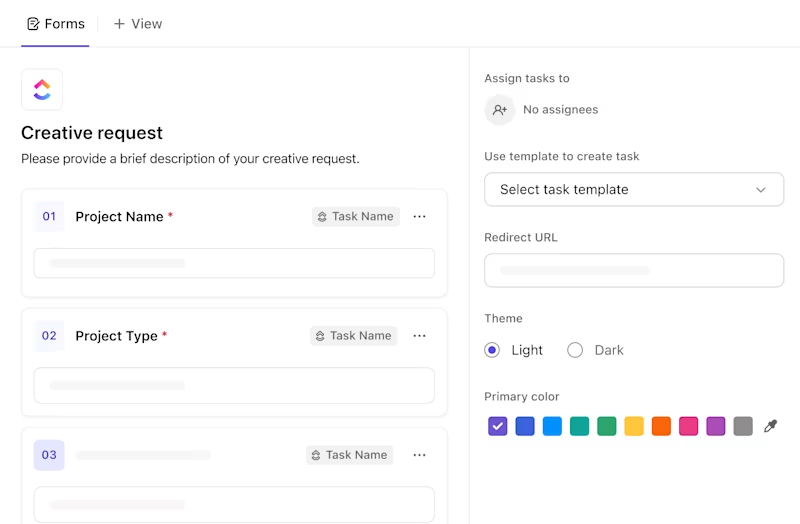Zoho Forms is a popular tool for creating customized forms for data collection, customer feedback, and project management.
However, if you’re seeking more advanced automation, seamless integrations, and greater customization options, several Zoho Forms alternatives may better suit your needs.
Whether you’re a business owner, marketer, project manager, or HR team member, the right form-building tool can make your data collection processes more efficient and organized.
Read on as we explore some of the top alternatives to Zoho Forms that offer diverse features and functionalities.
Top 11 Zoho Forms Alternatives for Smarter Data Collection
Where Zoho Forms Falls Short: 6 Limitations You Must Know
Zoho Forms works fine if you’re just getting started with data collection. It’s easy to use, integrates well with other Zoho products, and covers the basics for creating online forms. But as your needs grow, cracks start to show.
Here’s where it starts holding teams back:
- Limited customization options: You can change colors and fonts, but if you’re aiming for fully customized forms that align with brand guidelines or campaign aesthetics, the tool feels restrictive
- Lack of advanced templates: The template selection is minimal, which forces teams to build forms from the ground up every single time
- Limited third-party integrations: Outside the Zoho ecosystem, it doesn’t play well with other apps, especially niche tools marketers and freelancers often rely on
- Slows down with large forms: If you’re trying to collect detailed information across multiple sections, the form performance noticeably drops
- Learning takes time: For users who aren’t already deep into Zoho’s comprehensive suite, the layout and logic can be unintuitive and slow down your workflow
- No true drag and drop: The form builder exists, but it lacks the flexibility and speed of modern drag-and-drop editors that others offer
Top Zoho Forms Alternatives at a Glance
Here are some Zoho Forms alternatives that don’t just match the basics—they give you more power, better customization, and fewer headaches:
| Tool | Best for | Use case |
|---|---|---|
| Workflow automation & task integration | Convert form responses into actionable tasks and trigger workflows instantly | |
| Jotform | Dynamic forms with logic and payment | Build advanced forms with payments, conditional logic, and automation |
| Microsoft Forms | Teams using Microsoft 365 | Internal surveys, onboarding, and quick data capture inside the MS ecosystem |
| Wufoo | Quick forms with built-in payment options | Collect payments, create surveys, and launch simple forms fast |
| Paperform | Branded forms with flexible logic | Build interactive forms with pricing rules, scheduling, and custom design |
| Typeform | Conversational forms & branded experiences | Create one-question-at-a-time forms for better engagement |
| Google Forms | Fast, free form creation with real-time data sync | Run internal polls, surveys, and quizzes with auto-sync to Google Sheets |
| Formstack | Secure forms & advanced workflow automation | Automate processes in healthcare, finance, and compliance-heavy workflows |
| Cognito Forms | Complex workflows & task-based automation | Use logic, eSignatures, and payments to power multi-step forms |
| 123FormBuilder | Compliance-driven forms for enterprise use | Create HIPAA/GDPR-compliant forms with deep Salesforce integrations |
| Formsite | Basic forms with document generation | Create secure forms that generate PDFs and automate workflows |
Top Alternatives to Zoho Forms
Not every team can—or should—stay boxed into the Zoho ecosystem. If you’re looking for Zoho Forms alternatives that offer more flexible form-building, better workflow automation, and seamless integration with your project management tool, we’ve got you covered.
Here are the top alternatives to consider:
1. (Best for workflow automation & task integration)
, the everything app for work, goes beyond basic task management. It brings docs, chats, whiteboards, goals, dashboards, time tracking, and more into a single platform, helping businesses centralize work and eliminate tool-switching.

Forms is deeply integrated into your workflows. When someone fills out a form, it can instantly trigger task creation, assign team members, and push updates to dashboards. That means no more checking submissions manually. This way, everything becomes instantly actionable.
Additionally, you can customize each form with logic-based fields, visuals, brand colors, and background images to match your team’s needs.
With Dashboards, you can quickly get an overview of your form submission data. Convert your form submissions into custom dashboards to have an always-updated visualization to refer to!
Dashboards can also help you manage data about your forms, such as submission percentages, time in status, etc., and drill down into specific tasks as well.
📮 Insight: Approximately 92% of knowledge workers are at risk of losing important decisions due to scattered documentation, with just 8% using project management tools to track action items.
With ’s Task Management capabilities, you never have to worry about this. Create tasks from chat, task comments, docs, and emails with a single click!
also offers feedback form templates with pre-designed fields and customizable options to help you easily collect valuable insights, whether from customers, employees, or stakeholders.
’s Feedback Form Template comes with pre-configured custom fields, views, and statuses. It helps you track responses, rate service providers, and spot recurring issues—all in one place.
You can also use sign-up form templates to manage event registrations, collect contact information, or solicit job applications. also has intake form templates to help you manage client expectations and spin up complex forms, dashboards, and workflows instantly.


Based on form responses, Automations can help you set up rules to auto-assign tasks, change priorities, update statuses, send emails, and more—without lifting a finger. It’s built for teams who want to eliminate repetitive admin work.
It can be used as a powerful form automation tool, helping optimize data collection, trigger actions based on form responses, and automate workflows, all in one place.
best features
- Build tailored forms and share or embed them anywhere
- Turn form submissions into actionable tasks with marketing automation triggers and assignee rules
- Reduce manual reporting with AI-powered summaries and project updates with Brain
- Build rich dashboards that update in real time using form and task data
- Find all your forms centrally organized in a searchable Forms Hub in
- Extend your form’s functionality through ’s 1000+ integrations with tools like Slack, HubSpot, and more
limitations
- The form builder isn’t available in the mobile app
- Takes some time to fully customize dashboards for first-time users
pricing
free forever
Best for personal use
Free Free
Key Features:
unlimited
Best for small teams
$7 $10
Everything in Free Forever plus:
business
Best for mid-sized teams
$12 $19
Everything in Unlimited, plus:
enterprise
Best for many large teams
Get a custom demo and see how aligns with your goals.
Everything in Business, plus:
* Prices when billed annually
ratings and reviews
- G2: 4.7/5.0 (9,000+ reviews)
- Capterra: 4.6/5.0 (4,000+ reviews)
Philip Storry, Senior System Administrator, said:
2. Jotform (Best for powerful forms with built-in payment and logic)
Jotform focuses on making form creation not just easy but also dynamic and functional for serious workflows.
It gives you access to smart conditional logic, payment integrations, and automated workflows without touching a single line of code. What stands out is the speed—you can build a polished, multi-functional form in minutes and embed it anywhere.
It’s built for teams that want to skip the tech hassles and launch forms that look good, function well, and connect with 150+ business tools. From asking for user feedback to internal approvals and registrations, it handles scale without losing simplicity.
Jotform best features
- Trigger workflows and notifications using conditional logic based on user responses
- Accept online payments directly through forms with Stripe, PayPal, and more
- Use 10,000+ templates to create anything from surveys to lead gen forms
- Connect with 150+ apps like Google Sheets, Mailchimp, Salesforce, and Slack
Jotform limitations
- Mobile responsiveness is inconsistent on some devices
- Some features feel hidden unless you’re already familiar with the platform
Jotform pricing
- Starter: Free
- Bronze: $39/month per user
- Silver: $49/month per user
- Gold: $129/month per user
- Enterprise: Custom pricing
Jotform ratings and reviews
- G2: 4.7/5.0 (3,500+ reviews)
- Capterra: 4.7/5.0 (2,400+ reviews)
3. Microsoft Forms (Best for teams already using Microsoft 365)
If your team is already working within the Microsoft 365 environment, Microsoft Forms is a simple yet efficient option for building employee surveys, polls, and quizzes without leaving the platform.
It syncs easily with Excel for data analysis, integrates with Teams for collaborative responses, and uses AI-powered suggestions to speed up form creation.
It’s clean, intuitive, and doesn’t require any setup if you’re already using Microsoft tools. For internal use cases—employee feedback, onboarding, or quick pulse surveys—it fits right in with the rest of the Microsoft stack.
Microsoft Forms best features
- Create surveys and quizzes quickly using smart suggestions and templates
- Seamlessly integrate with Excel, SharePoint, and Teams for real-time collaboration
- Customize forms with themes and media for a more engaging experience
- Access and manage responses across devices using your Microsoft 365 account
Microsoft Forms limitations
- It comes with limited visual customization compared to dedicated form builders
- Mobile responsiveness is inconsistent on some devices
Microsoft Forms pricing
- Microsoft 365 Business Basic: $7.20/month per user
- Microsoft 365 Business Standard: $15.00/month per user
- Microsoft 365 Business Premium: $26.40/month per user
- Microsoft 365 Apps for Business: $9.90/month per user
- Microsoft 365 Copilot: Available as an add-on to Business plans (Pricing not available)
Microsoft Forms ratings and reviews
- G2: 4.4/5.0 (300+ reviews)
- Capterra: 4.5/5.0 (200+ reviews)
Here’s what a G2 user said:
4. Wufoo (Best for quick form creation with built-in payment options)
Wufoo is a veteran in the form builder space, known for its ease of use and straightforward setup. If you need to spin up payment-enabled forms, surveys, or applications quickly, Wufoo delivers with pre-designed templates, drag-and-drop elements, and a user-friendly interface.
It’s especially appealing for users who want something lightweight, no-code, and quick to deploy. It also supports a range of payment processors like PayPal, Stripe, and Square, making it a go-to for donation forms, event payments, or registrations.
Wufoo best features
- Build and launch forms with 400+ templates and a user-friendly drag-and-drop builder
- Collect payments using Stripe, PayPal, Square, or Authorize.Net
- Customize form themes with your own branding using CSS or built-in designer
- Integrate with tools like Salesforce, Mailchimp, WordPress, and Asana
Wufoo limitations
- It comes with no CAPTCHA support, making it highly vulnerable to spam and bot abuse
- Security features are limited for payment-integrated forms
Wufoo pricing
- Free forever
- Starter: $22/month per user
- Professional: $39/month per user
- Advanced: $99/month per user
- Ultimate: $249/month per user
Wufoo ratings and reviews
- G2: 4.2/5.0 (290+ reviews)
- Capterra: 4.4/5.0 (200+ reviews)
🔎 Did you know? Forms that include logic-driven conditional flows can increase conversions by as much as 160%—especially for surveys, quotes, or bookings.
5. Paperform (Best for branded forms, payments, and flexible logic)
Paperform blends form-building with the design freedom of a landing page editor. It’s built to feel more like writing a doc than dragging boxes around—and that’s what sets it apart.
Whether you’re selling services, taking bookings, collecting customer feedback, or building customized forms with dynamic pricing rules, Paperform handles it all with one clean, minimal interface.
You can match your form to your brand, automate workflows, add calculations, and even turn your form into a mini storefront with payment support.
Paperform best features
- Build interactive forms that support logic-based pricing, scheduling, and payments in one place
- Add calculations, conditional flows, and dynamic success pages with zero code
- Embed e-signatures, collect bookings, and automate tasks via 2000+ integrations
- Fully customize visuals, typography, layout, and background to match your brand
Paperform limitations
- Limited search or filter options for multiple-choice questions with large answer sets
- Partial submissions are not always recoverable if a user drops off mid-way
Paperform pricing
- Essentials: $29/month per user
- Pro: $59/month per user
- Business: $129/month per user
- Enterprise: Custom pricing
Paperform ratings and reviews
- G2: 4.5/5.0 (40+ reviews)
- Capterra: 4.8/5.0 (100+ reviews)
From a G2 user:
6. Typeform (Best for conversational forms and branded experiences)
Typeform stands out from the various Zoho Forms alternatives with a design philosophy that’s all about talking with, not at your audience. Its one-question-at-a-time interface feels more like a conversation than a form, which increases engagement and completion rates.
You can embed videos, add logic-based follow-ups, and fully brand your forms—making them ideal for lead capture, surveys, and onboarding flows that don’t feel transactional.
Typeform also comes with smart insights, built-in analytics, and AI-powered response analysis, helping teams pull real meaning from their collected data.
Typeform best features
- Create versatile forms for surveys, polls, quizzes, assessments, and more
- Add video, custom variables, logic jumps, and conditional follow-ups without writing code
- Access detailed form performance analytics and question-level insights
- Export form responses into Excel or CSV files
- Integrate with 500+ tools like Google Sheets, HubSpot, Salesforce, Slack, and Calendly
Typeform limitations
- The basic plan lacks viewer-only seats, forcing workarounds for teams needing read-only access
- Response limits can add up quickly, making it costly for high-volume users
Typeform pricing
- Free
- Basic: $29/month per user
- Plus: $59/month per user
- Business: $99/month per user
- Growth Essentials: $199/month per user
- Growth Pro: $349/month per user
- Enterprise: Custom pricing
Typeform ratings and reviews
- G2: 4.5/5.0 (800+ reviews)
- Capterra: 4.7/5.0 (900+ reviews)
From a G2 user:
7. Google Forms (Best for quick, simple surveys with real-time collaboration)
Google Forms is the go-to choice for anyone already embedded in the Google ecosystem. It’s straightforward, fast, and built for seamless collaboration. It connects directly with Google Sheets for instant data sync and analysis.
Its drag-and-drop interface, real-time editing, and solid sharing options make it ideal for optimizing data collection. Best of all, it’s completely free with a Google account—no need to learn new tools if you’re already using Workspace.
Google Forms best features
- Collaborate on unlimited forms with your team in real time using the familiar Google Docs-style editor
- Embed forms on websites or share via email, social, or custom links in seconds
- Automatically organize responses in Google Sheets for easy access and reporting
- Use templates for quick creation or build custom quizzes, surveys, and sign-ups
Google Forms limitations
- It comes with limited visual customization options and a lack of advanced logic branching
- It can feel too basic for businesses needing more powerful workflows or integrations
Google Forms pricing
- Free forever
- Business Starter: $6/month per user
- Business Standard: $12/month per user
- Business Plus: $18/month per user
- Enterprise: Custom pricing
Google Forms ratings and reviews
- G2: 4.6/5.0 (42,000+ reviews)
- Capterra: 4.7/5.0 (11,000+ reviews)
From a G2 User:
8. Formstack (Best for building secure forms and automating workflows)
Formstack is built for teams that need Zoho Forms alternatives for more than building forms. It’s a complete workflow automation platform, combining forms, eSignatures, documents, and integrations into one toolkit.
The interface is beginner-friendly, but the power under the hood is serious—especially if you’re dealing with compliance-heavy industries like healthcare, government, or finance. Its features, like form prefill, task assignments, and logic-based workflows, help you turn any form into a fully functioning process. It’s not flashy, but it’s reliable and enterprise-grade.
Formstack best features
- Automate end-to-end workflows with forms that trigger document creation, task routing, and e-signatures
- Use Formstack for Salesforce to build and manage forms directly inside your Salesforce org
- Control permissions, assign reviewers, and track approvals across forms and documents
- Access workflow dashboards, dynamic task assignments, and advanced routing logic without writing a single line of code
Formstack limitations
- The form builder panel feels cramped and harder to navigate when building complex forms
- Field renames or deletions can break automated logic or notifications without warning
Formstack pricing
- Forms: $99/month per user
- Suite: $299/month per five users
- Enterprise: Custom pricing
Formstack ratings and reviews
- G2: 4.3/5.0 (450+ reviews)
- Capterra: 4.0/5.0 (100+ reviews)
💡 Pro Tip: Wondering how to ask for feedback to fuel professional growth?
Here are some tips to follow:
- Keep it concise and to the point to respect their time 🕒
- Ask specific questions to gather actionable insights 💬
- Focus on areas for improvement instead of general feedback 🎯
- Encourage honest, constructive criticism to promote growth 👂
9. Cognito Forms (Best for powerful workflows and task automation)
Cognito Forms brings together a balance of customization and automation. You’re not just collecting data—you’re using it to trigger workflows, assign tasks, generate documents, and even collect payments with Square or PayPal.
Its standout feature is Workflow Tasks, which lets you involve different users at different stages of a process—think approvals, follow-ups, and dynamic status changes.
You can also build complex forms with repeating sections, calculations, and advanced logic, all without writing code. It’s a solid pick if your form needs to go beyond simple data collection.
Cognito Forms best features
- Automate multi-step workflows with role-based status changes and in-app task assignments
- Use data lookups, calculations, and logic to build forms that adapt in real time
- Collect legally binding eSignatures and generate documents directly from submitted form data
- Accept payments with Stripe, Square, or PayPal and apply rules like quantity limits or discounts
Cognito Forms limitations
- Fewer customization options for form styling without adding CSS
- Embedding looks basic out of the box unless styled manually
Cognito Forms pricing
- Free forever
- Pro: $19/month for up to 2 users
- Team: $39/month for up to 5 users
- Enterprise: $129/month for up to 20 users
Cognito Forms ratings and reviews
- G2: 4.5/5.0 (80+ reviews)
- Capterra: 4.6/5.0 (130+ reviews)
From a G2 User:
10. 123FormBuilder (Best for compliance-driven forms and enterprise workflows)
123FormBuilder leans into security and compliance more than most. If your workflows involve sensitive data—think healthcare, government, or finance—this platform makes it easier to tick all the boxes. It covers everything from GDPR and HIPAA to advanced encryption and data residency options.
What makes it stand out is its tight Salesforce integration, support for 45+ native apps, and the ability to generate PDFs or custom reports right from the form submissions. Whether it’s a donation, patient intake, or registration, this is built for teams that need both control and flexibility.
123FormBuilder best features
- Build secure forms with data encryption, GDPR, and HIPAA compliance
- Push data directly to Salesforce, Google Sheets, or your CRM in real time
- Generate PDF documents and trigger email workflows post-submission
- Access 3000+ pre-built templates for everything from consent forms to evaluations
123FormBuilder limitations
- Occasional bugs during updates, especially around redirect URLs
- UI can feel inconsistent while building forms
123FormBuilder pricing
- Free forever
- Gold: $37/month per user
- Platinum: $49/month per user
- Diamond: $99/month per user
- Enterprise: $225/month per user (billed annually)
123FormBuilder ratings and reviews
- G2: 4.5/5.0 (160+ reviews)
- Capterra: 4.4/5.0 (170+ reviews)
💡 Pro Tip: When a form gets submitted (e.g., client request, internal feedback, or creative brief), don’t just send a notification—use task management tools that turn responses into structured tasks with deadlines, subtasks, and assigned owners.
It will help you:
- Gain insights by tracking submissions in real-time dashboards 📊
- Convert form submissions into actionable tasks with clear ownership ✅
- Set deadlines and subtasks to keep projects on track 📅
- Automate workflows to reduce manual follow-ups 🔄
11. Formsite (Best for basic forms and old-school reliability)
Formsite has been around since the late ’90s—and you can tell. While it may not win awards for modern UX or rapid innovation, it gets the job done. It’s reliable, secure, and packed with essentials like payment processing, PDF exports, multi-page logic, and robust integrations.
It also offers a decent 14-day free trial that doesn’t require a credit card, which is rare. If you’re looking for something rock-solid, but don’t care about bells and whistles or a shiny UI, Formsite is still a contender among other Zoho Forms alternatives.
Formsite best features
- Build forms effortlessly with a drag-and-drop editor, image and data upload, and 40+ question types
- Collect payments seamlessly using Stripe, PayPal, Braintree, and Authorize.net
- Secure submissions with CAPTCHA protection and SSL encryption
- Automate workflows with PDF output, save-and-return options, and advanced logic
Formsite limitations
- The UI feels outdated and clunky compared to newer tools
- Its pricing has crept up while features remain largely unchanged
Formsite pricing
- Personal: $24.95/month per user
- Professional: $39.95/month per user
- Business: $69.95/month per user
- Business Plus: $99.95/month per user
- Enterprise: $249.95/month per user
Formsite ratings and reviews
- G2: 4.4/5.0 (30+ reviews)
- Capterra: 4.5/5.0 (40+ reviews)
From a G2 User:
Additional tools worth exploring
Here are some additional form-building tools that offer unique features and capabilities and can be considered as Zoho Forms alternatives:
- FormKeep: Provides a lightweight form backend for developers who need frontend flexibility without heavy integrations
- SurveySparrow: Offers conversational surveys, recurring survey automation, and multi-device responsiveness
- FormAssembly: Focuses on enterprise data collection and Salesforce-native integration for secure workflows
Upgrade Your Forms and Workflow With
Forms streamline data collection and play a critical role in tracking progress and automating workflows.
Zoho Forms is a decent tool for basic form-building and data collection, but it comes with limitations—especially if your team needs more automation, flexibility, and seamless integration with other tools.
Whether you’re handling client management, collecting feedback, managing project requests, or automating approvals, there’s a smarter tool out there for your team.
The right form builder should do more than capture data; it should connect that data to your workflow, CRM, and decisions.
On this note, stands out among other Zoho Forms alternatives by offering powerful automation, deep integrations, and a project management suite designed to turn form submissions into real, actionable work. It helps you ditch the manual effort and switch to a tool that matches your team’s efficiency and growth.
Sign up on and upgrade your forms and workflow!


Everything you need to stay organized and get work done.














